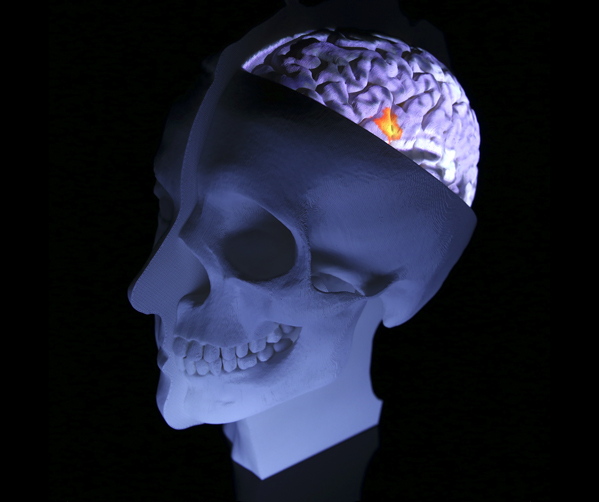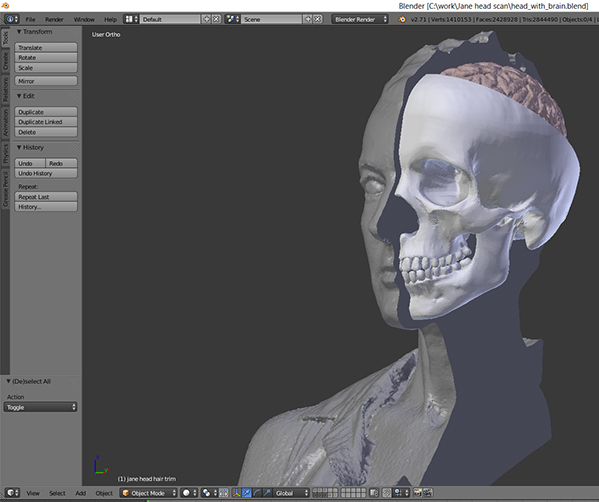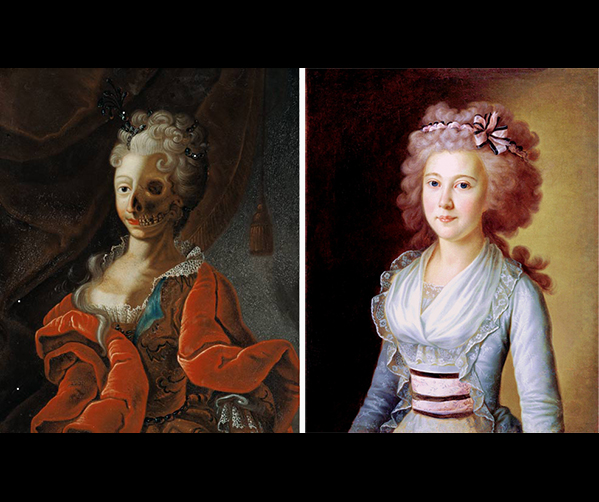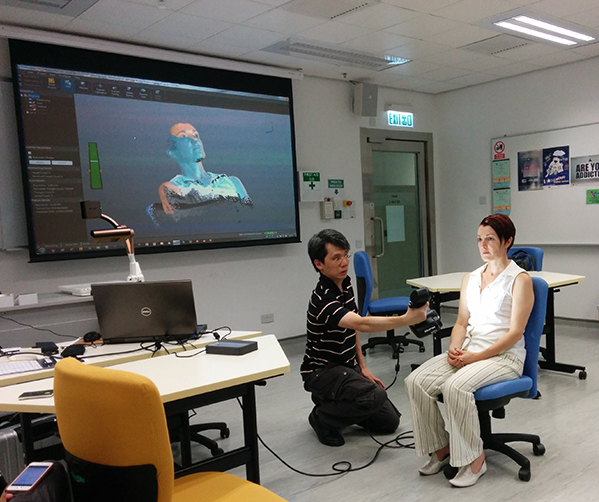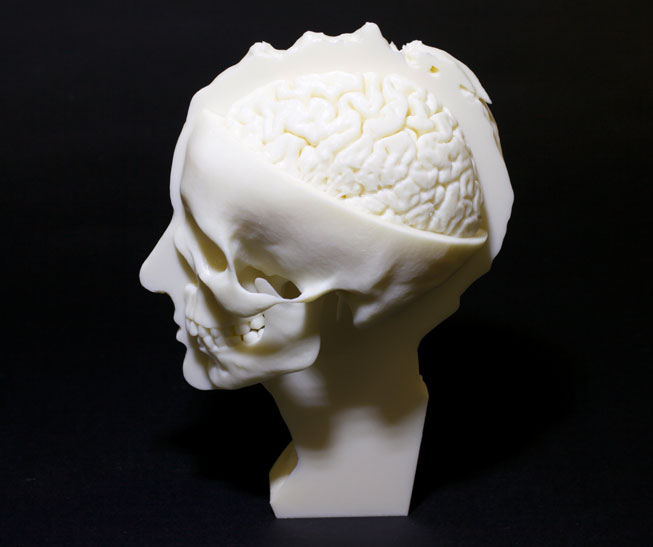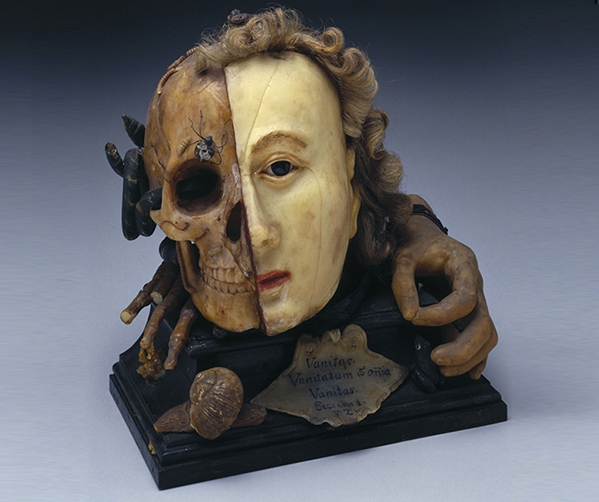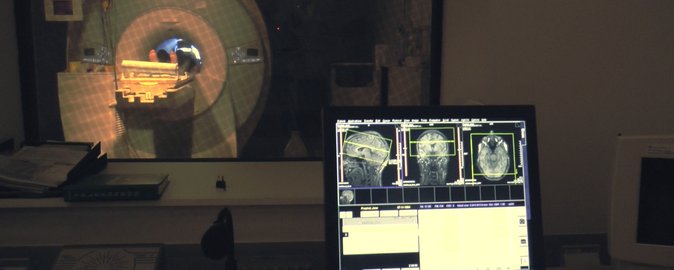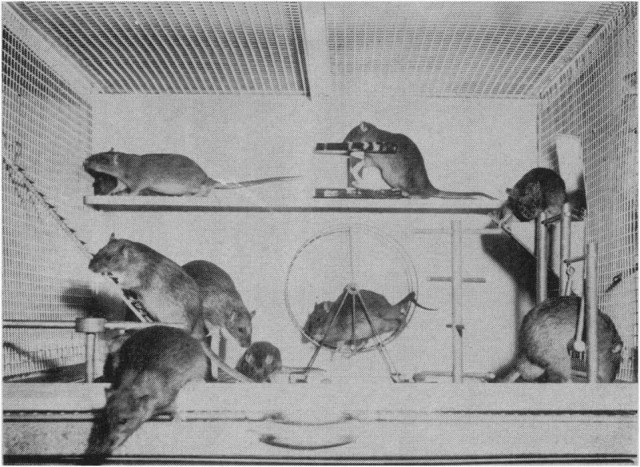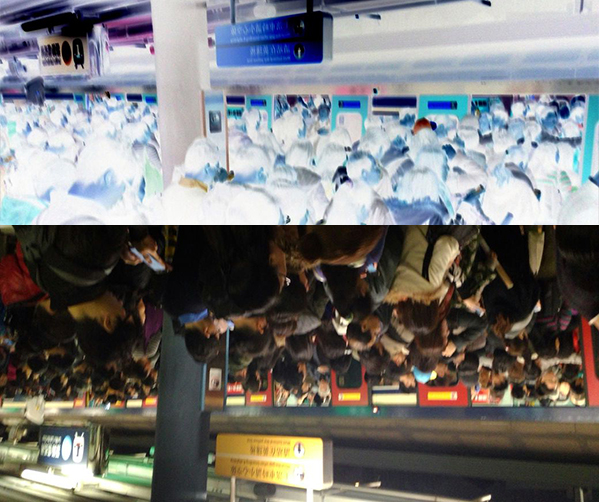I am currently producing live video and computer animations to be projection-mapped onto the 3D printed sculpture. The projection of moving images onto the sculpture animates the 3D object and blends images of the living (MRi data and live action video) with images that allude to the dead (like the skull model). This bringing together of images or symbols of life/the living and death/the dead is typical of memento mori, but in this project it is achieved using contemporary imaging technologies. Some of the animations are derived from the fMRI data showing brain activity whilst looking at memento mori images (see the still image of the video being projected onto the 3D print above).
Combining 3D scans and MRI data
3D scans of the artist’s head and face were combined with MRI data defining the brain, resulting in one digital 3D model shown above. The final model shows a dissected head, recombined with a 3D skull and brain model. The form of the final, life-sized portrait sculpture refers to the Wellcome Trust object, seen here.
fMRI experiment design: looking at memento mori
Left: Arcimboldo Giuseppe (1527-1593) – La Vanita. Right: Yermolai Kamezhenkov (1790) A Portrait of a Young Lady: E. N. Likhachyova
We designed an experiment with me as a subject, looking at representations of memento mori while in a Magnetic Resonance Imaging (MRI) scanner to record my brain activity via functional MRI (fMRI). For this experiment we used two sets of images. Set ‘A’ comprised memento mori and vanitas works from a range of time periods and featured both paintings and sculptural objects. Set ‘B’ were the ‘control’ images. These were paintings and objects, again produced across a range of times in keeping with the other set, Set ‘B’ were all figurative, with subjects who were very much alive as opposed to Set ‘A’ that featured the dead or images of dead and alive human subjects. Before each image was shown I saw a linguistic cue, a short text, either “Live the now”, or, “You will die”. An image was then randomly selected and displayed for 7 seconds. Though we never used images from each set shown side-by-side in our experiment, I have used illustrated this post with an image from each set.
Head scanning and hair gel
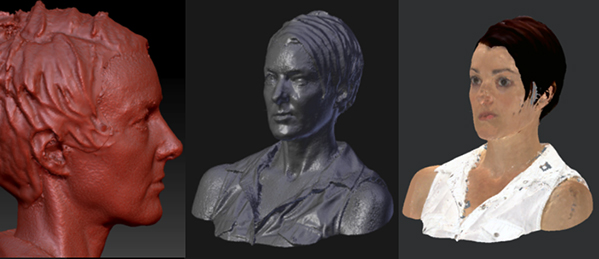
We tried a couple of different scanners for the head scan to make the 3D model of my face and neck. Shadow and dark hair is hard to scan and the top photo shows how the technician passes the scanner with a bright light under my chin to scan the shadowy area. Many people with black hair dust their hair with a white talcum powder to make it easier for the scanner to ‘see’. The fine strands of hair are also hard to capture – this is like the early days of green screen technology in video with hair looking fuzzy. My solution was to work with that constraint and so I hair gelled my hair to give it more shape and definition which was easier for the scanner to pick up. I kind of like the Max Headroom look!
We used two hand-held 3D scanners, first the Go!SCAN scanner which captured high detail and facial geometry data. As a single scan covers a limited surface area, moving the scanner to make multiple scans is necessary to create a complete a facial model that is accurate and detailed. We had captured the rough shape of the heavily gelled hair, but the Go!SCAN’s high resolution struggled to identify the detail of the hair structure so we switched to another scanner. The Sense scanner by Cubify scans at lower definition but suited our purpose – to capture the hair as a larger solid shape.
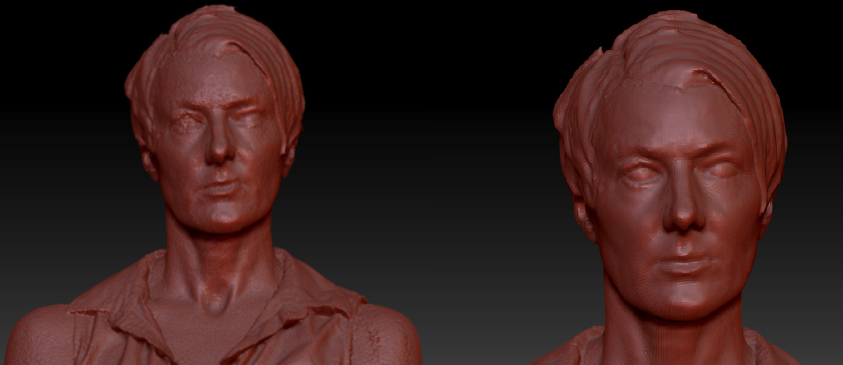
The result is this model. Some parts of the left hand side image, such as the mouth, look distorted. We think that this is because it is difficult for a person to keep perfectly still during the multiple passes of the handheld scanner and Jane smiled part way through. Every subtle movement leads to displacement and distortion in the final results. The image on the right shows the model after the distortions were fixed, fairly quickly, by Ivan using ZBrush sculpting tools and photo references. Finally, the model was completely remeshed to redistribute vertices evenly and to reduce the vertices count and close holes, making the model 3D-printing friendly.
Neuro memento mori: a portrait of the artist contemplating death
Welcome to Jane Prophet’s project that explores brain activity during the contemplation of artworks and death.
The questions that underpin this project are:
Can contemporary neuroscience and new imaging technologies increase our understanding of consciousness?
When we look at memento mori artworks are we prompted to contemplate our own mortality?
What parts of the brain are active when we look at these artworks?
What parts of the brain are active when we meditate on death?
Is there any similarity in brain function in these two instances?
Wax model of a Female head depicting life and death
“Wax model of a Female head depicting life and death” (Unknown 1701-1800). Image courtesy The Wellcome Trust and Science Museum, London.
Neuro Memento Mori is inspired by the object shown above from the Wellcome Trust Permanent Collection. It shows a woman’s bisected head, the left half apparently a detailed portrait of a living woman, open-eyed, with painted lips and blond hair arranged in ringlets. Her left hand frames her face while the right half of her head is shown in post mortem decay. Resting on her skeletonised right hand, her skull crawls with insects, maggots and worms. A snake emerges from her empty eye socket. As we look at memento mori artworks such as this compelling object, I questioned whether we ‘remember, we must die’? What parts of our brain are active when we look at these artworks, and, when we contemplate death by meditation, without looking at memento mori art?
Sweating the small stuff is good!
Death meditation.
Today, when contemplating ‘what I will miss’ when I die I struggled to come up with anything! This made me realise what a stressful day or two I had experienced with work demands and family commitments. I had a clear sense of ‘what I will not miss’ – fulfilling obligations.
It was a matter of moments before, not surprisingly, I became aware of being overblown, of thinking of ‘big stuff’. Then, immediately, I found much to miss: the flowers I pass on my way to work, the plants outside, the feel of kneading bread dough, the fun of cooking.
Time to bring it all down to everyday moment by moment detail. That’s what I lose when I succumb to stress and push ahead to complete what feels like too many tasks – I stop being in the moment.
Seminar at Interacting Minds: Comparing neural activity during two death-related psychological processes
On January 27th 2015, 11.00-12.30 I will give a talk at Interacting Minds Centre, Aarhus University
I introduce my art practice, focusing on previous collaborations with scientists, then present interdisciplinary work in progress with Aarhus University, City University Hong Kong and New York University. This research uses brain imaging to attempt to reveal the neural mechanisms underlying death-related psychological processes. For hundreds of years memento mori and vanitas artworks had an alleged function – to prompt the viewer to contemplate their own mortality. This collaborative research gathers fMRI data via two related single-subject fMRI experiments. This data is used to produce a range of outputs, ranging from sculptural 3D printed objects, displayed at Moesgaard Museum, Aarhus, Denmark to academic papers. See here for more details.
Rat runs
Death meditation. I will miss the physical thrill of sprinting, of laughter. I won’t miss striving, grant-writing and form-filling. I won’t miss the rat race.
Death comes and my body rots. l feel rats tugging at my body, eating it from the inside too. I don’t need this body any more. It’s ok.
Anger, pain and expectations
Death Meditation.
It took longer (15 minutes) for me to quieten as I was so wound up. When thinking what I would not miss it was clear as a bell: anger, pain. People that are difficult and who let me down. Not surprisingly that when I thought about what I would miss it was people!! Their love, support, warmth.
This sort of mirroring or one thought being the flip-side of the previous one seems to be common in my meditations now. No idea if that’s typical or whether I may be like a record stuck in a groove.
Quickly following on from these two thoughts came the inevitable recognition that my anger came from feeling hurt- and that means I must have had expectations. As I imagined dying all anger left, a huge sadness followed, then that too passed. Then a sense of love. I kept my focus on myself reduced to a pin point of white light.
